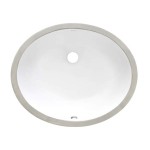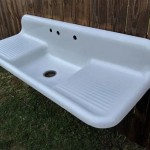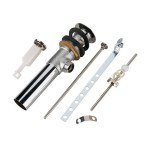How To Remove Stains From Ceramic Sinks
Ceramic sinks, prized for their durability and classic aesthetic, are a common fixture in kitchens and bathrooms. However, their smooth, non-porous surface is susceptible to staining from various sources, including food particles, hard water deposits, and cleaning product residue. Successfully removing these stains requires a methodical approach, utilizing appropriate cleaning agents and techniques to restore the sink's original luster without causing damage.
This article provides a comprehensive guide on removing stains from ceramic sinks, focusing on practical methods and preventative measures. Understanding the types of stains commonly encountered, the appropriate cleaning supplies to use, and the correct application techniques are essential for achieving optimal results and extending the lifespan of the sink.
Identifying Common Stain Types
Before attempting to remove any stain, it is crucial to accurately identify its nature. This identification process dictates the most effective cleaning solution and method to employ. Common types of stains found on ceramic sinks include:
Hard Water Stains: These stains appear as white or grayish-white deposits, often near the faucet or drain. They are caused by mineral buildup from hard water, primarily calcium and magnesium. The severity of hard water stains can vary depending on the water's mineral content and the frequency with which the sink is cleaned.
Food Stains: Food residue, particularly from coffee, tea, berries, or tomato-based products, can leave behind unsightly stains. The longer these food particles remain on the sink surface, the more difficult they become to remove. Pigmented foods are particularly prone to causing persistent stains.
Rust Stains: Rust stains are typically reddish-brown and result from contact with iron or other metallic substances. Leaky faucets, metal cookware, or even certain cleaning tools can contribute to rust stains on ceramic sinks.
Soap Scum: This is a white or grayish film that accumulates due to the reaction between soap and hard water minerals. Soap scum can be particularly difficult to remove, especially if it is allowed to build up over time.
Ink or Dye Stains: Accidental spills of ink or dye can result in colored stains on the sink surface. The type of ink or dye involved will influence the choice of cleaning agent.
Essential Cleaning Supplies and Tools
Having the right cleaning supplies and tools readily available is essential for efficient and effective stain removal. The following items are typically required:
Mild Dish Soap: A gentle dish soap is a fundamental cleaning agent for removing everyday grime and light stains. Choose a pH-neutral formula to avoid damaging the ceramic surface.
Baking Soda: Baking soda is a mild abrasive that can effectively remove stains without scratching the ceramic. It is also a natural deodorizer.
White Vinegar: White vinegar is an acidic solution that is effective at dissolving hard water stains and soap scum. It should be diluted with water before use to prevent damage to the sink's finish.
Lemon Juice: Similar to white vinegar, lemon juice is a natural acid that can help to remove stains and leave a fresh scent.
Hydrogen Peroxide: Hydrogen peroxide is a mild bleaching agent that can be used to remove stubborn stains, such as those caused by coffee or tea. Always test in an inconspicuous area first.
Soft Cloths or Sponges: Use non-abrasive cloths or sponges to avoid scratching the ceramic surface. Microfiber cloths are particularly effective at lifting dirt and grime.
Old Toothbrush: An old toothbrush can be used to scrub hard-to-reach areas and to remove stains from around the faucet and drain.
Spray Bottle: A spray bottle is useful for applying cleaning solutions evenly to the affected area.
Rubber Gloves: Wearing rubber gloves protects hands from harsh cleaning chemicals and prevents skin irritation.
Eye Protection: Eye protection, such as safety glasses or goggles, should be worn when using cleaning products that could potentially splash.
Step-by-Step Stain Removal Techniques
The following techniques outline specific methods for removing various types of stains from ceramic sinks. Always start with the gentlest method and gradually increase the intensity of the cleaning solution or technique as needed. Thoroughly rinse the sink with clean water after each cleaning step.
General Cleaning with Mild Dish Soap: For everyday cleaning and the removal of light stains, use mild dish soap. Wet the sink with warm water and apply a small amount of dish soap to a soft cloth or sponge. Gently scrub the entire surface of the sink, paying attention to areas with visible stains. Rinse thoroughly with clean water and dry with a clean cloth.
Baking Soda Paste for Stubborn Stains: Create a paste by mixing baking soda with a small amount of water. Apply the paste to the stain and let it sit for 15-20 minutes. Gently scrub the area with a soft cloth or sponge. Rinse thoroughly with clean water. For more stubborn stains, consider mixing the baking soda with white vinegar instead of water, though be prepared for bubbling and use appropriate safety measures.
White Vinegar Solution for Hard Water Stains and Soap Scum: Mix equal parts white vinegar and warm water in a spray bottle. Spray the solution onto the affected area and let it sit for 15-30 minutes. Scrub the area with a soft cloth or sponge. Rinse thoroughly with clean water. For severe hard water stains, you may need to soak a cloth in the vinegar solution and place it directly over the stain for a longer period.
Lemon Juice for Stain Removal and Freshening: Cut a lemon in half and rub the cut side directly onto the stain. Let the lemon juice sit for 30 minutes to an hour. Scrub the area with a soft cloth or sponge. Rinse thoroughly with clean water. The citric acid in lemon juice acts as a natural cleaning agent and leaves a pleasant scent.
Hydrogen Peroxide for Coffee, Tea, and Dye Stains: Pour hydrogen peroxide directly onto the stain and let it sit for 30 minutes to an hour. Scrub the area with a soft cloth or sponge. Rinse thoroughly with clean water. Test the hydrogen peroxide in an inconspicuous area first to ensure it does not discolor the ceramic. This method is particularly effective on stains from organic sources.
Commercial Ceramic Sink Cleaners: If natural remedies are not effective, consider using a commercial ceramic sink cleaner. Follow the manufacturer's instructions carefully and always test the cleaner in an inconspicuous area first to ensure it does not damage the sink's finish. Choose a cleaner that is specifically designed for ceramic surfaces and avoid using abrasive cleaners or scouring pads.
Rust Stain Removal: For rust stains, try using a commercial rust remover that is safe for use on ceramic surfaces. Apply the rust remover according to the manufacturer's instructions and rinse thoroughly with clean water. Alternatively, a paste of baking soda and lemon juice can be applied to the stain and left to sit for several hours before scrubbing and rinsing.
Preventative Measures to Minimize Staining
Preventing stains from occurring in the first place is the most effective way to maintain the appearance of a ceramic sink. Incorporating the following preventative measures into a regular cleaning routine can significantly reduce the likelihood of staining:
Rinse the Sink After Each Use: Rinsing the sink with water after each use helps to remove food particles and other debris that can cause stains if left to dry.
Dry the Sink Regularly: Drying the sink with a clean cloth after each use helps to prevent water spots and hard water stains from forming.
Use a Sink Grid or Protector: Placing a sink grid or protector in the bottom of the sink can help to prevent scratches and stains from pots, pans, and other items.
Avoid Leaving Staining Substances in the Sink: Do not leave staining substances, such as coffee grounds, tea bags, or berry juice, in the sink for extended periods.
Clean the Sink Regularly: Regularly cleaning the sink with mild dish soap and water helps to prevent the buildup of dirt, grime, and stains.
Consider a Water Softener: If hard water is a persistent problem, consider installing a water softener to reduce the mineral content of the water.
By following these steps, individuals can effectively remove stains from ceramic sinks and maintain their beauty for years to come. Consistency in cleaning and prompt attention to spills are key to preventing stubborn stains from setting in.

How To Clean Kitchen Sink And Make It White Again

How To Clean A Ceramic Sink Tap Warehouse

How To Remove Stains From A Porcelain Sink Isavea2z Com

3 Ways To Clean A Ceramic Sink Wikihow

How To Clean A Ceramic Sink Mumsnet

How To Clean A Porcelain Sink Lemons Lavender Laundry

How To Clean Ceramic Sinks A Simple And Effective Guide Sparkling Beyond

How To Clean An Enameled Cast Iron Kitchen Sink The Inspired Hive

How To Clean A White Enamel Sink Look Like New

How To Remove Rust Stains From A Porcelain Sink







